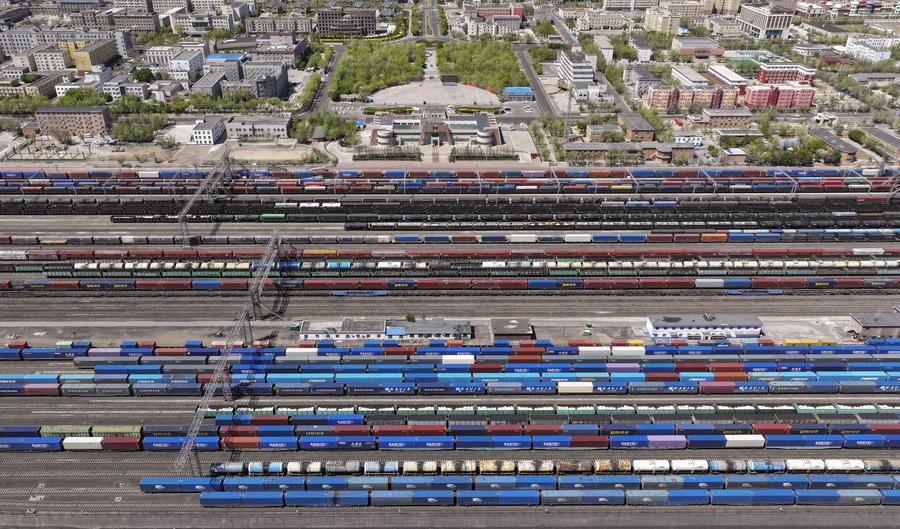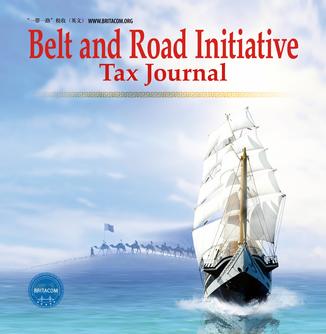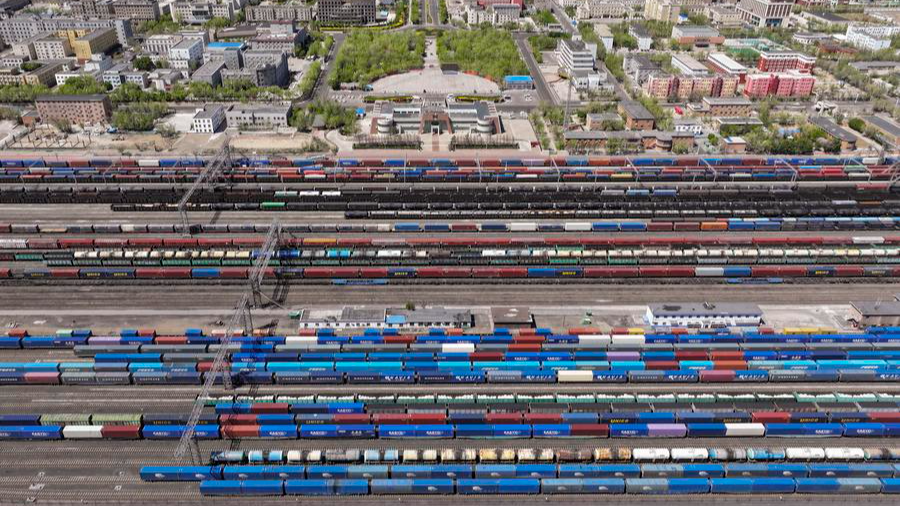A drone photo taken on May 25, 2024 shows freight trains waiting for departure at the Alataw Pass in northwest China's Xinjiang Uygur Autonomous Region. (Photo by Yu Hui/Xinhua)
URUMQI, Feb. 13 (Xinhua) -- Despite mounting pressure from Western countries over issues like so-called "forced labor" and import restrictions and sanctions, northwest China's Xinjiang Uygur Autonomous Region has achieved a historic high in foreign trade in 2024.
Last year, the region's import and export value surged to 435.11 billion yuan (about 60.68 billion U.S. dollars), marking a 21.8 percent year-on-year increase and underscoring its remarkable resilience and vitality.
To date, more than 3,000 state-owned and private enterprises are actively engaged in foreign trade in the region.
Yu Chengzhong is a witness of the rapid growth of Xinjiang's foreign trade over the past three decades.
In 1997, Yu pioneered fruit export in Xinjiang by transporting tangerines from Urumqi, the region's capital city to Horgos, a key port city.
He later established Jinyi Group, which has grown into one of the region's leading foreign trade enterprises. In 2024, the company's import and export value exceeded 2.2 billion U.S. dollars, with plans to target 2.6 billion U.S. dollars this year.
"We now transport over 2,000 tonnes of agricultural products and daily necessities every day," Yu said. "Thanks to the favorable policies of the free trade zone, customs clearance has become faster, enabling us to handle larger international orders with confidence."
China (Xinjiang) Pilot Free Trade Zone (FTZ) was established in November 2023. It encompasses three iconic areas -- Urumqi, Kashgar and Horgos -- stands as the first FTZ in China's northwestern border regions and the 22nd nationwide.
The robust growth in Xinjiang's foreign trade is underpinned by strong policy support, as well as an array of measures to streamline customs clearance and improve related services.
"The customs authorities have implemented a series of specific measures to enhance supervision efficiency and service quality, ensuring the high-quality development of Xinjiang's foreign trade," said Li Qinghua, a customs official of Urumqi.
As the Belt and Road Initiative (BRI) continues to forge ahead, Xinjiang has committed to building itself into an important corridor linking Asia and Europe and to serving as a gateway for China's opening-up efforts in the west.
Russian entrepreneur Barsalkinov believes he is a beneficiary of BRI. Barsalkinov established a trade company in Xinjiang that produces noodles and rapeseed oil using Russian ingredients, which have been well-received by Chinese consumers. His products are sold not only in Xinjiang but also in other provincial-level regions like Gansu, Sichuan, Guangdong, Guangxi, Hunan and Hubei.
"The preferential policies in the FTZ have helped us reduce operating costs, expand our business scope and access broader markets," said Yu Xiangyang, the company's factory manager.
The company has seen continuous orders from major supermarkets in Xinjiang, with daily production capacity reaching up to around 15 tonnes. In 2024, sales of rapeseed oil surged by 50 percent compared to the previous year, according to Yu Xiangyang.
In 2024, Xinjiang established trade relations with 213 countries and regions, with imports and exports to BRI participating countries increased by 18.7 percent. Meanwhile, trade with member countries of the RCEP (Regional Comprehensive Economic Partnership) and ASEAN (Association of Southeast Asian Nations) also saw growth, increasing 167.8 percent and 191.9 percent, respectively.





 A single purchase
A single purchase








